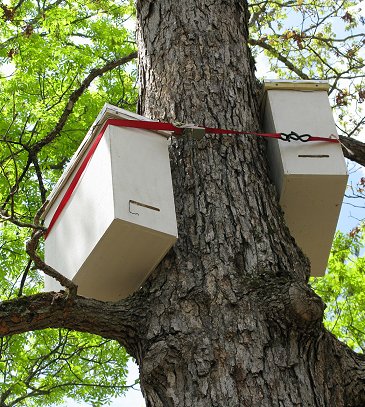AgEBB-MU CAFNR Extension
Green Horizons
Volume 21, Number 1
September 2016
Non-Timber Forest Products
You Can Keep Bees, Naturally!
By Leo Sharashkin | PhD
Keeping bees can be simpler than growing tomatoes, but many beekeepers' experiences today are downright discouraging. "My mother spent $5,000 on her bees in the first few years", Alan told me. Indeed, here is a typical scenario: you attend a beginner beekeeping class, buy equipment and protective gear, order a package of bees, install them in the hive, treat against parasites and disease, feed in the fall and then... they do not survive the first winter. You buy more bees the following spring and the cycle repeats itself. Faced with very high bee mortality, even many expert beekeepers hang it up.
What gives? After all, historical records show that a hundred years ago Missouri farmers commonly had multiple hives in their backyards. Bees required hardly any care and yet produced a honey crop five seasons out of six. Georges de Layens, one of Europe's leading beekeepers, once emphasized that sustainable beekeeping rests on two principles: use local bees and keep them in appropriate hives that are matched to the climate of your region. These simple rules still hold today, and following them makes beekeeping what it once was - a joyful and productive occupation that requires relatively little effort and brings great rewards.
But where do you buy local bees? The good news is you don't have to buy them. Sometimes, the best things in life are free, and bees are no exception. Just as birds occupy bird houses, local honeybee swarms will move into large boxes (called 'bait hives') placed in trees in the springtime. Bee colonies multiply by splitting in two or more parts - casting swarms. These swarms send out hundreds of scouts to find a new home, and if they discover your box scented with propolis (bee resin) and lemongrass essential oil (two smells attractive to bees), they will likely move in. For every ten boxes I deploy in April, five will be occupied by bees before June is over. Bait hives quickly pay for themselves with the first swarm you catch, and they can be used for many years.
 |
"Bait hives" positioned in a tree to attract swarms of local bees! |
To maximize your chances of attracting a swarm to your bait hive, it must be between 10 and 15 gallons in volume and should be placed 12-15 feet off the ground in a tree that stands out (on the edge of the woods, in a fencerow, along power lines or roads, in front or back yards, etc.). The box must be highly visible but in full shade to prevent overheating. Check it periodically, and when the swarm moves in (you'll see heavy traffic of bees leaving and entering) bring it down from the tree at nightfall and move it to where your permanent hive will be located.
Starting with colonies of local wild bees offers multiple advantages. Swarms are usually much larger (4-5 lb's) than commercial packages (2-3 lb's) and are free. A commercial package of bees will cost about $150. And, unlike the mass-produced commercial bees that come largely from the southern (Italian) stocks and may not be suited for your climate, local bees are truly adapted to the region's conditions, are more resilient and more disease resistant.
Once you obtain your first colony, you need to give them a good home - transfer them from the temporary swarm box into a stationary, durable, well-insulated, easy-to-build and easy-to-manage hive. I give preference to Layens horizontal hives that require no heavy lifting and are gentle on the bees, allowing them to live a better life to what they would have in the wild while producing a handsome surplus for you the beekeeper.
So do you have local bees buzzing around a good hive you gave them? You can now rest. The bees will do the rest.
About the author
Leo Sharashkin received his PhD in Forestry from the University of Missouri, Center for Agroforestry. He is editor of Keeping Bees With a Smile, a comprehensive book on natural beekeeping, and is a regular contributor to the American Bee Journal, Bee Culture, Acres U.S.A., and other major publications. He lives on a forest homestead in the Ozarks where he catches wild honeybee swarms and keeps bees in several dozen, easy-to-build horizontal hives. Leo teaches natural beekeeping at his apiary and around the country and internationally. His website (including free hive plans): www.HorizontalHive.com.
